#Jurassic nautilus
Explore tagged Tumblr posts
Photo

RARE Spiroceras bifurcati Heteromorph Ammonite & Cenoceras inornatum Nautilus Fossils Jurassic Dorset COA
A truly exceptional and rare paired fossil specimen, this multi-block features the co-preservation of a heteromorph ammonite, Spiroceras bifurcati, alongside a Jurassic nautilus, Cenoceras inornatum. It was discovered by our own team members, Alister and Alison, on 30 April 2025 at the world-renowned Jurassic Coast near Burton Bradstock, Dorset, UK.
This remarkable fossil combination comes from the Inferior Oolite Formation, a Middle Jurassic unit famous for beautifully preserved marine life.
Species Overview:
Spiroceras bifurcati: A rare heteromorph ammonite with a distinct open-coiling or spiral morphology, unlike the typical planispiral ammonites. Its shell features bifurcating ribs and irregular coiling, a defining characteristic of heteromorph taxa.
Order: Ammonitida
Superfamily: Stephanoceratoidea
Family: Unknown/rarely classified due to unique form
Geological Stage: Bajocian (~170 million years ago)
Depositional Environment: Shallow carbonate marine shelf
Cenoceras inornatum: A smooth-shelled Jurassic nautiloid with a classic involute coiled form and a central siphuncle. It was likely a slow-moving predator or scavenger.
Order: Nautilida
Family: Nautilidae
Geological Stage: Bajocian (Middle Jurassic)
Depositional Environment: Shallow, warm marine waters of the oolitic platform
This fossil has been expertly cleaned, prepped, and treated by Alison, and its superb preservation highlights the distinct features of both species. The photo shows the exact specimen you will receive, and includes a 1cm scale cube for accurate sizing—please refer to the image for full details.
All of our fossils are 100% genuine specimens and come with a Certificate of Authenticity (COA), confirming their identity and provenance.
This is an extremely rare pairing, ideal for advanced collectors, museums, educational institutions, or anyone with an interest in unique and scientifically significant fossil specimens.
Origin: Burton Bradstock, Dorset, United Kingdom
Formation: Inferior Oolite
Age: Bajocian Stage, Middle Jurassic (~170 Ma)
Species: Spiroceras bifurcati & Cenoceras inornatum
Discovered by: Alister and Alison (30 April 2025)
Prepared by: Alison
Authenticity: 100% Genuine Fossil with COA
#Spiroceras bifurcati#Cenoceras inornatum#heteromorph ammonite#Jurassic nautilus#fossil ammonite#fossil nautilus#rare ammonite#Inferior Oolite fossil#Jurassic Coast fossil#Burton Bradstock fossil#Dorset fossil#ammonite with COA#Middle Jurassic fossil#Jurassic ammonite nautilus#authentic UK fossils
0 notes
Text




Results from the #paleostream
Traquairius, Acropiyadi (spec evo animal from Lemuria), Lishulong and Cenoceras rumelangense (the largest known nautilid).
515 notes
·
View notes
Text
New Giant Nautilid species
a new species of Cenoceras, C. rumelangense, from the early Bajocian Humphriesianum Zone of Luxembourg and Southwest Germany. Heres an image of Robert Weis for human scale, followed by figures from the paper. The Cenoceras rumelangense n.sp., paratype from figure 9 is my favourite, look how wide this fellas opening is.
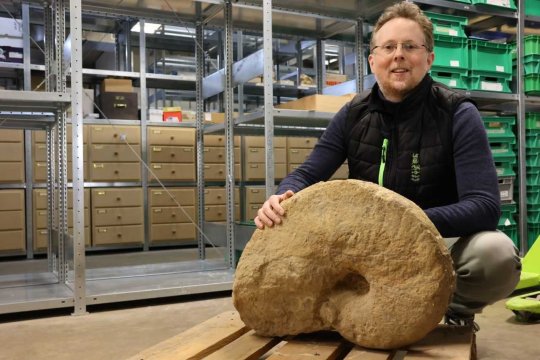
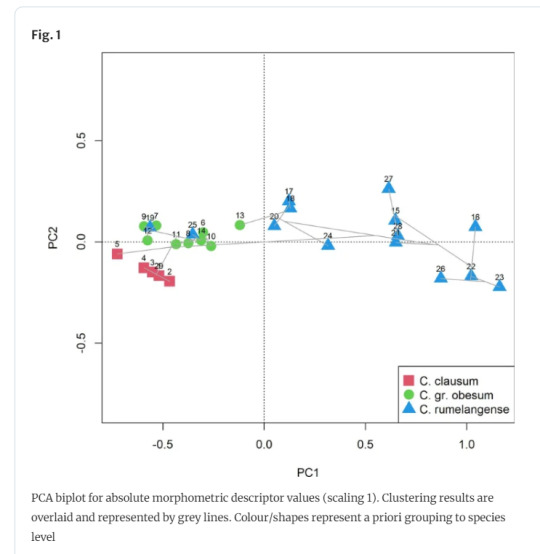
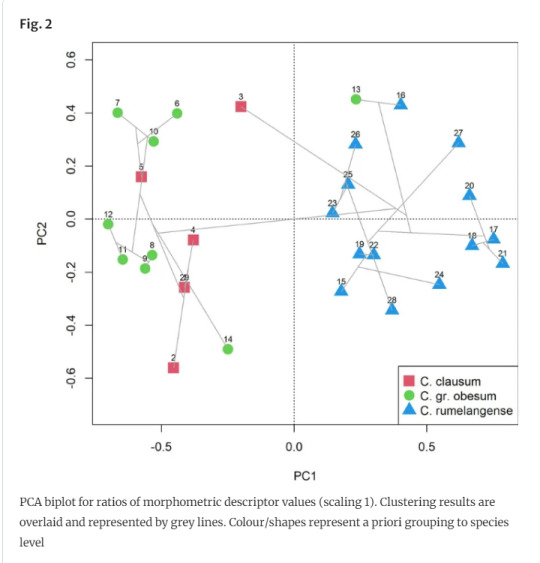
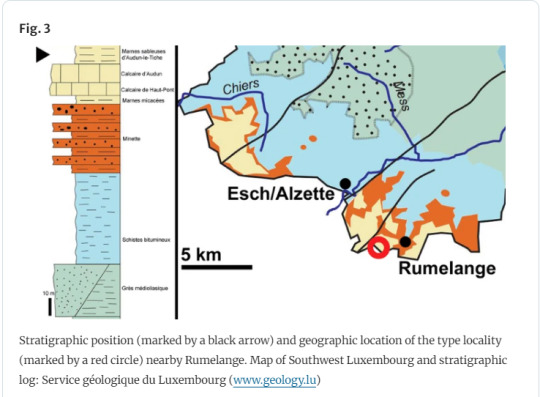
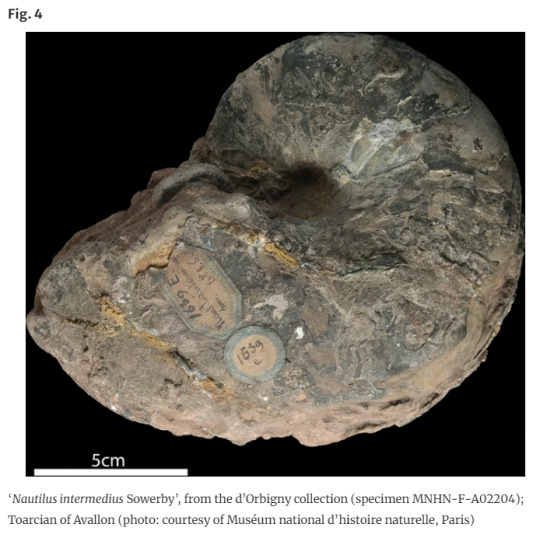
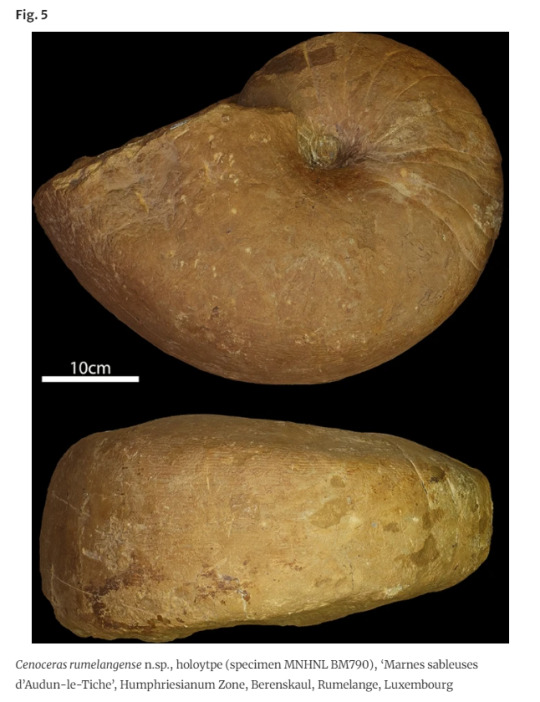
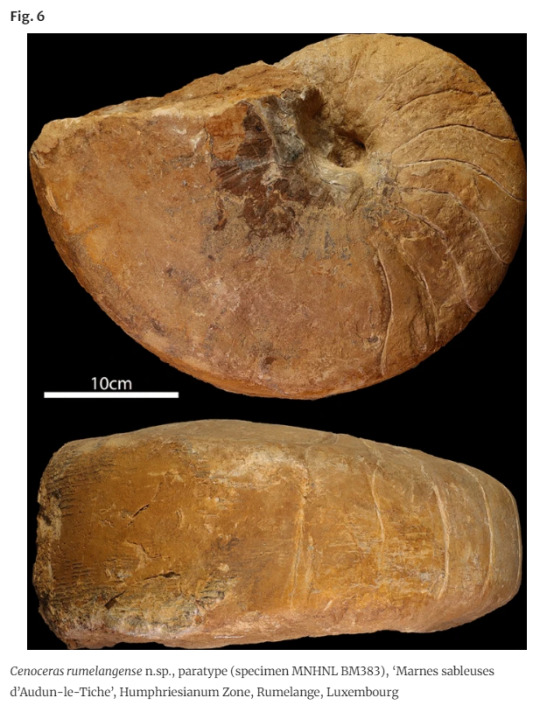
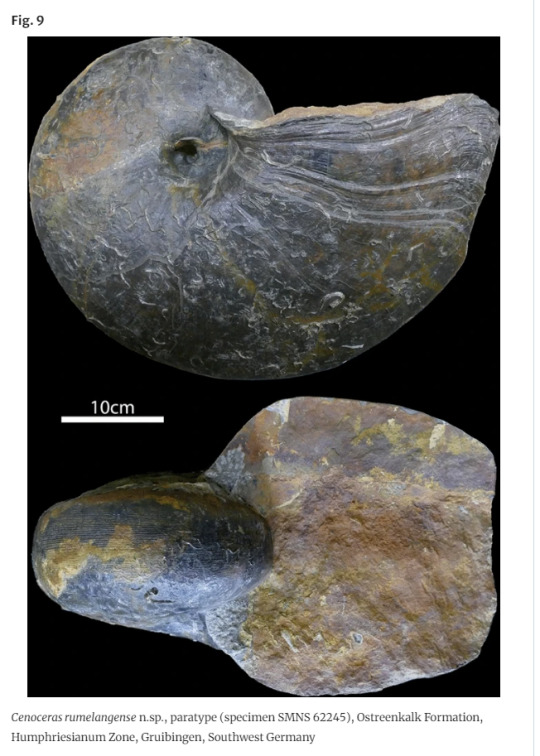
10 notes
·
View notes
Text
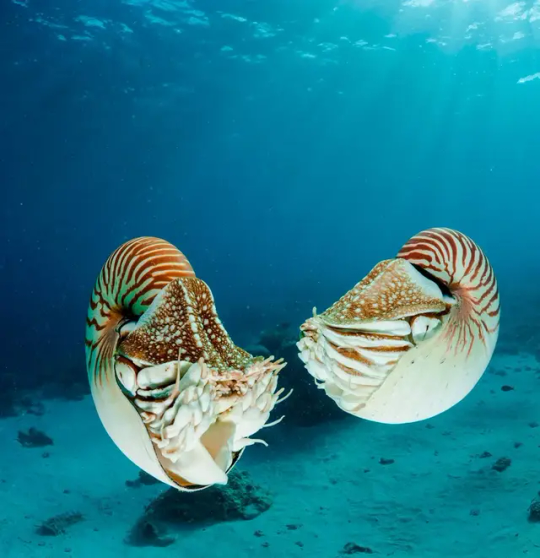

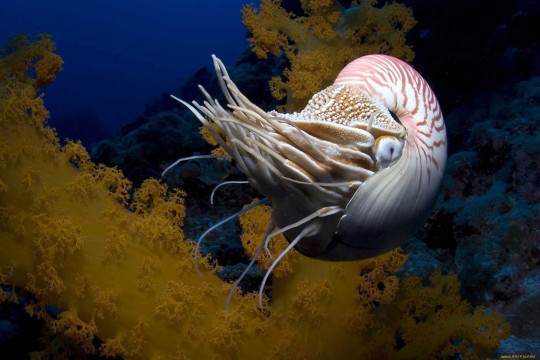
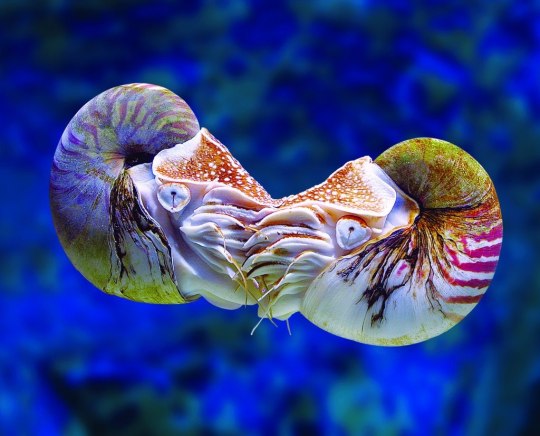
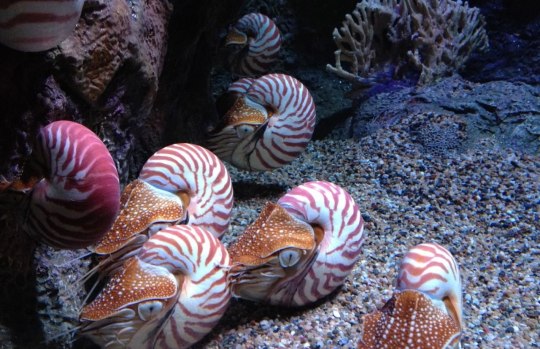
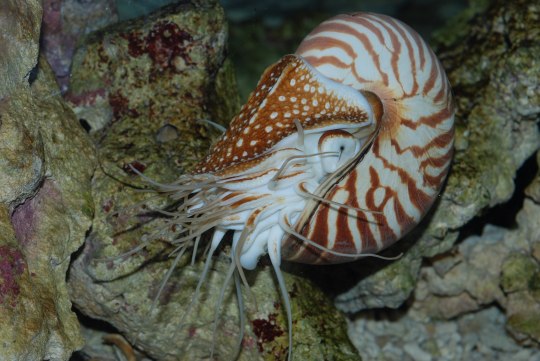
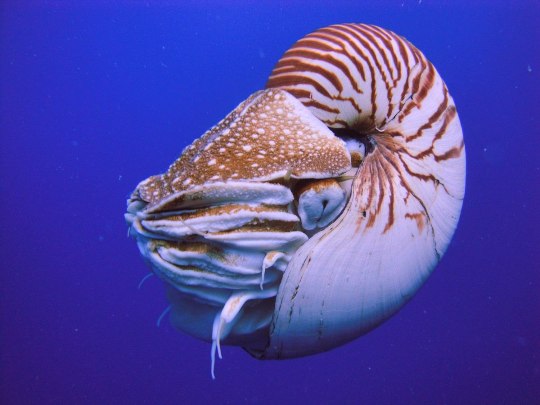
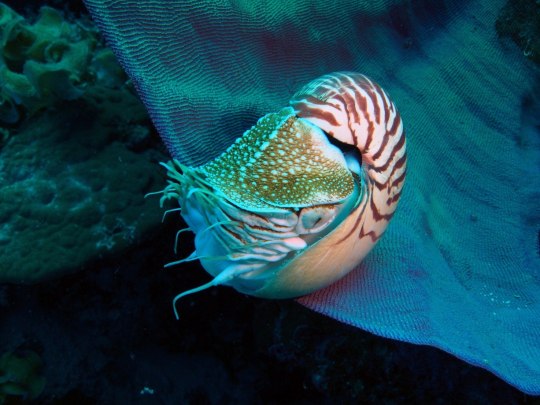




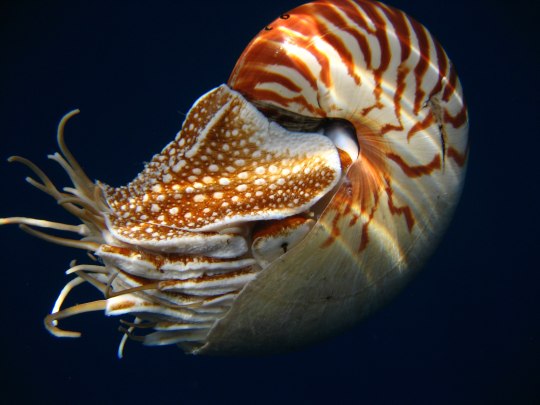
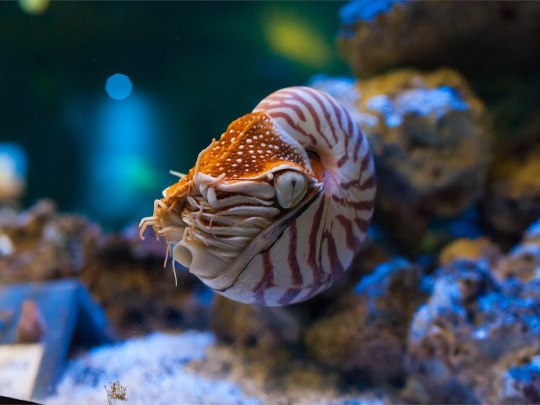
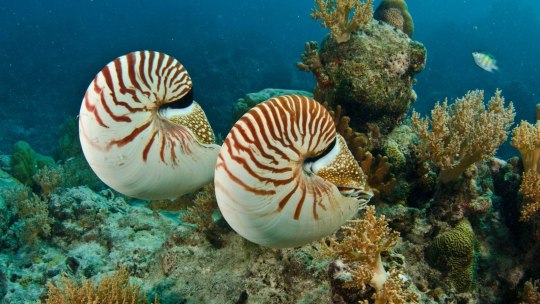
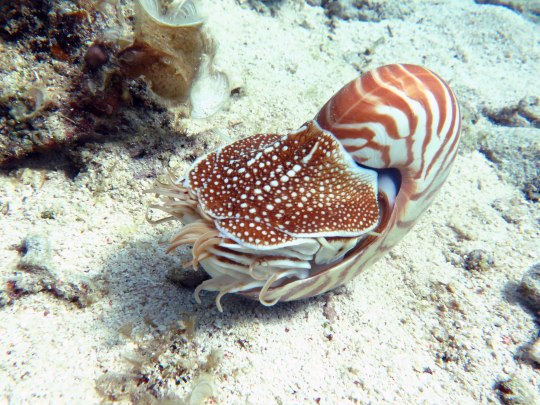
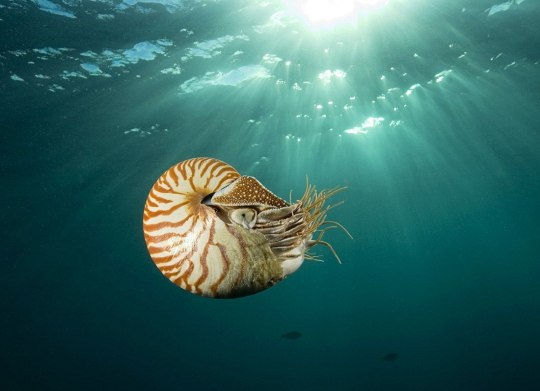

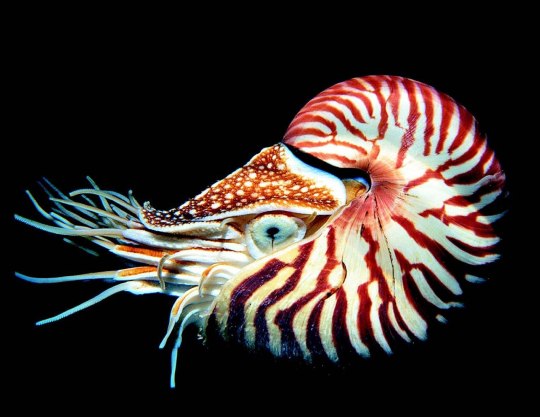

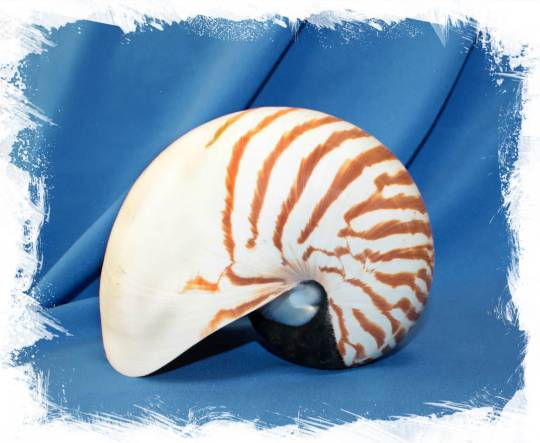
Наутилус (лат. Nautilus) — род головоногих моллюсков, которых относят к «живым ископаемым». Самый распространенный вид — Nautilus pompilius. Наутилусы относятся к единственному современному роду подкласса наутилоидей. Первые представители наутилоидей появились в кембрии, а его развитие пришлось на палеозой. Наутилиды почти вымерли на границе триаса и юры, но все же дожили до наших дней, в отличие от своих родственников аммонитов. Некоторые виды древних наутилусов достигали размера в 3,5 м. Представители самого крупного вида современных наутилусов достигают максимального размера в 25 см.
Спиральный «домик» моллюска состоит из 38 камер и «построен» по сложному математическому принципу (закон логарифмической прогрессии). Все камеры, кроме последней и самой большой, где размещается тело наутилуса с девятью десятками «ног», соединяются через отверстия между собой сифоном. Раковина наутилуса двухслойная: верхний (наружный) слой – фарфоровидный – действительно напоминает хрупкий фарфор, а внутренний, с перламутровым блеском – перламутровый. «Домик» наутилуса растет вместе с хозяином, который перемещается по мере роста раковины в камеру попросторней. Пустое жилище моллюска после его гибели можно встретить далеко от его места обитания – после гибели «хозяина» их раковины остаются на плаву и перемещаются по воле волн, ветров и течений.
Интересно, что двигается наутилус «в слепую», задом наперед, не видя и не представляя препятствий, которые могут оказаться на его пути.И еще одно удивительное качество этих древних обитателей Земли – у них потрясающая регенерация: буквально через несколько часов раны на их телах затягиваются, а в случае потери щупальца быстро отрастает новое.
Nautilus is a genus of cephalopods, which are classified as "living fossils". The most common species is Nautilus pompilius. Nautilus belong to the only modern genus of the Nautiloid subclass. The first representatives of the Nautiloids appeared in the Cambrian, and its development took place during the Paleozoic. The Nautilids almost died out on the border of the Triassic and Jurassic, but still survived to the present day, unlike their Ammonite relatives. Some species of ancient Nautilus reached a size of 3.5 m. Representatives of the largest species of modern nautilus reach a maximum size of 25 cm.
The spiral "house" of the mollusk consists of 38 chambers and is "built" according to a complex mathematical principle (the law of logarithmic progression). All chambers, except the last and largest, where the nautilus body with nine dozen "legs" is located, are connected through holes with a siphon. The nautilus shell is two–layered: the upper (outer) layer – porcelain–like - really resembles fragile porcelain, and the inner, with a mother-of-pearl luster - mother-of-pearl. The nautilus's "house" grows with its owner, who moves as the shell grows into a larger chamber. The empty dwelling of a mollusk after its death can be found far from its habitat – after the death of the "owner", their shells remain afloat and move at the will of waves, winds and currents.
Interestingly, the Nautilus moves "blindly", backwards, without seeing or imagining the obstacles that may be in its path.And another amazing quality of these ancient inhabitants of the Earth is that they have amazing regeneration: in just a few hours, the wounds on their bodies heal, and in case of loss of tentacles, a new one grows quickly.
Источник:://t.me/+t0G9OYaBjn9kNTBi, /sevaquarium.ru/nautilus/, /habr.com/ru/articles/369547/, //wallpapers.com/nautilus, poknok.art/6613-nautilus-molljusk.html, //wildfauna.ru/nautilus-pompilius, /www.artfile.ru/i.php?i=536090.
#fauna#video#animal video#marine life#marine biology#nature#aquatic animals#cephalopods#Nautilus#nautilus pompilius#living fossils#ocean#benthic#coral#plankton#beautiful#animal photography#nature aesthetic#видео#фауна#природнаякрасота#природа#океан#бентосные#головоногие моллюски#Наутилус#живое ископаемое#коралл#планктон
189 notes
·
View notes
Text
Hivy, This is Ivy!
Throughout my time on Tumblr one of my favourite things to do has been to create hypothetical Minecraft updates, I've done this twice before with The Pigeon update and The Pond Update, but a few weeks ago I let you lot chose what geographic area I should turn into a hypothetical update
Yall chose Celtic Europe (and Oceania but that's for later) AKA, Ireland, Scotland, Whales and Cornwall. I was very glad with this outcome as I myself am Scottish and I had a lot of ideas for this…..too many ideas…. So many ideas that I had to cut an entire section and now some stuff feels barebones….whoops. (but hey now I can work on a full portion update later…yay.)
But, enough of that, let's move on to:
The Fae Update!
New Biomes + Structures
There are 6 new biomes in this hypothetical update, each referring a different local found in celtic europe these are: The White Cliffs,The Glacial Pass, The Wisteria Forrest The Heather Moorlands/Peat Bogs (take your pick), The Highland Forests, and… you'll see ;3
The White Cliffs
The White Cliffs are a new coastal biome, consisting of grass topped cliffs, sandy bays and rock structures jutting out of the water. Suspicious sand and gravel generates naturally here and loot from it follows the fishing loot table, though with an increased chance to find nautilus shells and a rare chance to find sniffer eggs
This biome is based on the White Cliffs of Dover and the Jurassic Coast
The White Cliffs has only three new features:
Puffins
A new passive abiant mob, they drop Feathers when killed. Instead of the normal birds nest (introduced in the pigeon update) puffins lay there eggs in “wall nests” grey nests that attach to walls, these can be used as a decorative block
Seagulls
A neutral mob who drops Feathers and fish when killed, they spawn both in the White Cliffs and on beaches and open Seas. Seagulls will attack the player if they are holding any food item in their hand, stealing it.
Seagulls serve no other purpose.
Chalk
Chalk is a new stone block. It has the blast resistance of wood and is exclusive to the white cliffs, making up the cliffs themselves.
Chalk can be dyed any of the dye colours in the game, creating a softer, more Pastel variant of that colour (queers rejoice). Chalk can be made into slabs, stairs and walls in the stone cutter.
The Glacial Pass
A cold mountainous biome, the Glacial past is mainly made of stone and deeplate, with ice and snow also being common. Dipstone spikes can be found here as well as gravel structures resembling Eskers and Terminal Moraines (yes my favourite subject is geography how can you tell?). Suspicious gravel can be found here as well as suspicious snow, which can also be found in the igloo. Strays, Polar Bears, Foxes and Rabbits Spawn in this environment
This biome is based on glaciated uplands
Seals
Seals can be found in all cold environments. Seals will follow the player when they swim, upon coming on to land Seals will bob in the afternoon expectantly.
Seals can be fed fish, clapping after this is done
Seals drop blubber when killed. Blubber can be crafted into blubber blocks, when lit on fire these blocks burn light yellow. Blubber can be used to make torches, lanterns and campfires.
Blubber can also be crafted into a chest plate, the blubber chest plate reduces projectile damage and prevents Frost damage in powdered snow, but it slows you down while on land
The Wisteria Forest
A replacement for the old flower Frocester, this is a rare forrest in which all natural flowers spawn
Purified water (a type of water introduced in the pond update that can cure harmful status effects and restore hunger permanently for a short time) would spawn here too, as well as unicorns and kelpies (introduced in the pond update, will be discussed later)
Other Mobs that Spawn here will be discussed later
Wisteria Trees
Wisteria trees are a new wood type. The wood itself is a pale green with a purplish grey bark. Wisteria leaves are pale lavender. Wisteria trees also have hanging leave variants, much like willow leaves (pond update) that grow in the same way as glow berries
Butterflies and Moths
Passive ambient mobs that spawn in all biomes, though moths are most common in dark oak forests and butterflies are most common here. Both come in many colours, much like tropical fish. These mobs are as large as the bees (traditional dictates that all Minecraft arthropods must be massive, also yes bane of arthropods works on these, but do you actually care?)
Butterflies and Moths drop their respective wings when killed, these can be grafted onto the elytra (using the dragonfly carapace, an mob drop from the dragon fly as introduced in the pond update, speaking of that, the Toad from that update will also eat Moths and Butterflies) grafting these wings on changes the electable texture to resemble the wings of these Mobs (Note: despite both having many textures the electric will always adopt The Lunar Moth and Monarch Butterfly texture respectively)
Crann Bethadh Sprout
The sprout of a legendary tree, this is a two tall plant with ever changing leaf colours, shifting throughout all the pastel colour variants
The player can take a cutting of this plant using shears
This plant can only be dug up by the sniffer
Flower Crowns
By combining any 4 flowers in a circular pattern in the crafting table players can make flower crowns. Flower crowns adopt the colours of whatever flowers were used to craft it. Flower crowns can be worn on the head and serve no purpose other than to make people look pretty ;3
Wisteria Grass
Wisteria grass is a new grass type block that is pale lavender. It behaves the same as grass. It is only found in the Wisteria forest
The Heather Moorlands
Heather Moorlands are made up of water, grass, mud and a new block. No trees and few other plants spawn here, but cattails, reeds (pond update), sea grass and lily pads would be common here.
Bogs would spawn here
Toads, Frogs and Dragonflies would spawn here
Heather Moorlands are based on….Heather Moorlands.
Peat
Peat is a new powered snow-like block. It is brown in colour and makes up most of the ground in the Heather moorlands. Any plant can be planted on it.
Falling through peat takes notably longer than it does for powdered snow, players cannot freeze in peat, only suffocate. Peat can be safely traversed with leather boots.
When broken, peat will break into Peat Logs, peat logs can be burned in the furnace as an effective fuel
When lit on fire, Peat burns Bright Red, peat logs can be used to make peat lanterns, campfires and torches.
Combining 4 peat logs together makes a peat block, smelting a peat block creates Hardened Peat. Harmed peat can be made into Smooth Peat, Chiselled Peat, Peat Bricks, Cut Peat, Peat Pillar and Peat Tiles
Gortach
The Gortach are a new Undead mob. They spawn in swamps and peat bogs and resemble Bog bodies. They hide in dirt, mud, sand, gravel and peat and jump out of the ground to attack.
Gortach inflicts poison with their attacks. Gortach can carry swords, axes, and spears
Gortach drop their weapon, peat logs or Rotten flesh when killed
Spears
Spears are crafted either with one iron ingot and two sticks in a diagonal pattern, or are dropped by the Gortach
Spears are weaker than the sword but have a better reach, can be thrown (though this isn't good for their durability) and completely bypass shields and armour, hitting the opponent as if they had nothing at all
Spears have all the same enchantments as the Sword + Loyalty
Heather
Heather is a new purple flower exclusive to the Heather Moorlands. It gives purple dye when ground up.
The Highland Forest
Made up of rolling hills and Birch trees, all normal passive Mobs can spawn here, but sheep, goats,bees and cows are most common. All normal hostile Mobs can spawn here
Loch Lurkers (a rare UnderWater horse-like mob from the pond update) also spawn in the lakes here
Birch Updates
Yep. This is a secret Birch forest update.
A new form of Birch tree “Silver Birch” that grows much taller and has yellow leaves can be found here. This form gets its own sapling
The Birch block would also get a minor update to make the black segments more like stripes and not ugly blobs
Leave Updates, Packed Leaves and Thatching
Players and Mobs can now walk and fall through leaves.
When breaking leaves with anything other than shears or silk touch leaf blocks will drop leaf items (except wisteria and Spruce, which drop Petals and Needles)
By placing 9 of these in the crafting bench the player can create packed leaves, a new solid version of the leaf block
Thatching is a new block of greyish colour that is crafted with 6 wheat on the top and bottom and 3 leaves of any type in the centre of the crafting bench. Thatching looks the same as a Hale Bale, only without the string holding it together.
Goosegrass, Nettles, and Thistle
Goosegrass is a plant that grows in any forest, but is most common in the Highlands. Walking through goosegrass results in it sticking to you, taking up one of your unoccupied armour slots and slowing you down. Walking through it at all also slows you down, much like cobwebs, making this plant dangerous when fighting mobs
Nettles can only spawn in Dark oak and Highland forests. Nettles stay low to the ground, if they are walked on by a player they are inflicted with Poison. Nettles can be collected and made into a healthy soup
Thistles are a new type of two high flowers. They can be ground into purple dye. They hurt the player if walker through
Deer
Deer are a new mob found in all forested environments, much like Wolf's they have different textures depending on the biome
When killed, Deers drop Venison, a new edible meat
Like Goats, Deers will try to charge the player. Also like Goats, after hitting a block deer will drop and antler
Fog
Fog is a new weather type, lowering the amount the player can see for a short time and allowing a few Mobs to spawn, particularly endermen
Shelf Fungus
A new decorative block that grows on trees
Wildcats
Wildcats are a new ambient Mob, they share a model with Ocelots and Cats and they drop string when killed
The Mushroom Grotto
Oh yes. A new forest of giant mushrooms and mycelium. This biome is very rare. The Mobs that Spawn here will be discussed later
Mushroom Wood
Much like the nether mushrooms, overworld mushrooms are now a woodtype. The mushroom stem can be stripped and converted into all wood blocks. Mushroom wood is white in colour.
New Mushrooms
Yep. There is now a mushroom for every colour of dye in the game. Mushrooms can also now be ground into dye
Here's what all those mushrooms could look like (minus brown and red of course):

(Note: this is based on design, not colour)
Before moving on, sniffers don't just get the Crann Bethadh Sprout. They get a new plant for every dye type in the game
Plus, they can dig up two new mushrooms exclusive to them, when ground these mushrooms become two new dye types… Well, not quite. They Become Rose Dye and Spring Green Dye, the two removed wool colours. This is the only way to get these mushrooms and these dyes. This would make the sniffer more worth the work put in to get one and create a lot of more strange decoration choices
Here's what they COULD look like (note: again, colours don't line up)

Mushroom bricks
Smelting the Mushroom blocks (not the stem, the block itself) creates mushroom bricks: multicoloured bricks taking on the patterning of the mushroom used to make them
Mushroom bricks can be made into stairs, slabs and walls
Puffball Mushrooms and Faerie Rings
Both exclusive to the mushroom forest.
Puffball mushrooms are brown in colour and are plants that stay on the ground, when walked over they release spores that inflict harmful status effects such as Poison, blindness, slowness, weakness, nausea, lethitatvia, and mining fatigue
Faerie Rings are Rings of mushrooms that take up one block on the ground (they also come in all colours)
If a player steps on one it is like they are walking through cobwebs, and upon getting out they will be inflicted with slowness.
If a mob steps in one they completely freeze and their AI is disabled until they are knocked out or the ring is broken.
This would help allow players to use Mobs as decoration without lagging there game
New Structures
Bothies
A bothy is a public structure found typically in the Highlands, there small houses for folks to take shelter in.
Bothines can spawn in any woodland biomes, they'll appear as a simple wooden house. Inside Bothies will have a chest with low level loot and a bed.
Occasionally, suspicious sand,mud, gravel or snow will spawn outside the bothy (depending on the biome), these typically have low level loot but items such as armour Trims or record disks can be dug up
Stone Works
Based on the numerous palaeolithic celtic stoneworks,these are small abiant structures spawning in the Dark Oak, Highland and Wisteria forests, as well as Heather Moorlands, Snowy Tundras, Wetlands and Mushroom Grottos
There would be many variants of these structures resembling stone circles, stone henges, standing stones, stone portals and cobbled walls.
All of these are made from base stone blocks, though sometimes other blocks can be found like chalk flooring or trees/water spawning in the centre of a stone circle
Sometimes, though rarely, these structures could spawn with a “Stone Holder” a new block that holds a tool or weapon (similar to the myth of the sword and the stone) these can be moved with silk touch. The player can remove the weapon, which will always be made of iron (that's important for later) and could have some low-level enchamtmants
Occasionally, these can also structures spawn with suspicious dirt, which can be dug up with the brush. Pottery sherds are more common in these structures, but apart from that, they exist only as set dressing ;)
Castle Ruins
A more substantial ruin, Castle Ruins can spawn basically anywhere, but are most common in Highland forests.
Castle Ruins are winding structures, they have a Dungeon below with Gortach or Bog spawners in the cells. The main ruin itself is made up of narrow passageways, imagine a smaller version of the bastion.
There would be numerous loot chests around, but upon opening one, a new mob would be summoned called a ■■■■■■
This mob will be discussed later :)
The Beast's Lair
An underground structure most common under the mountains or Highland forests
Made up of narrow passages leading to open rooms filled with gold blocks, loot chests containing riches and even some new vaults. There's also a shocking amount of skulls littered around
And of course the new boss here: The Wyvern
The Wyvern is a draconic boss mob spawning only hear, it has 4 legs and two wings and is bright red (Note: no. Wyvern never meant a dragon with only 4 limbs. That is a modern addition. Wyvern and dragons were different because of what they breathed)
The Wyvern is very powerful up close and can attack from far away with its poisonous breath
Upon its defeat the Wyvern will drop copious amounts of gold and emeralds that it ate, perhaps even some diamonds if your lucky
Faerie Mounds
Spawning exclusively in the Wisteria Forests, Highland Forests and Mushroom Grottos, these are small dirt hills with a spawner inside and a handful of loot chests
They are essentially fae Dungeons
The mobs that Spawn here will be: you guessed it, discussed later
Clochan + The Dubnos Tunnels
Clochans are typically just an abiant structures common in the Highlands, small cobblestone huts with nothing interesting about them.
But occasionally, they lead to something greater. Some of them spawn with holes leading to a second structure made up of 5 rooms, oriented in this pattern:

In the centre room are 5 stones, each baring a carving of one of the 5 element symbols (note: these are taken from the unused painting textures, with a new one added for wood), at the base of all these stones is a new kind of Vault “The Fae Vault” exclusive to this structure and the beast's lair
The carvings look like this:

The goal of this structure would be to go to each of the challenge rooms, each of with have there own stone with a carving, right click on said carving to indicate you have completed the room, and once all 4 rooms are complete return to the centre room to click on the craving that was not represented by one of the carvings in the other rooms. Getting this right results in the appearance of 5 Fae keys from the stones. These keys can be used on the fey vaults to claim the structures loot
Failure to complete the structure will be indicated by the carvings glowing Red and numerous waves of Mobs spawning
The challenge rooms each contain a challenge pertaining to their element: the fire room is filled with fire, the water room is flooded, the air room requires parkour, the earth room is a Maze and the plant room is filled with Sweet Berries, Goosegrass, Nettles, Thistles, Puffball mushrooms and Faerie Rings (yes I know mushrooms aren't plants, shush.)
On top of that, there are several spawners for the fae in this structure, with various types appearing to attack you. Though these spanners will be deactivated upon completing a room
(Note: carved stones can be moved with silk touch)
They fae Mobs that Spawn in these will be discussed later.
These structures would create unique challenges for the player and would bring more life to these biomes, encouraging exploration.
(Part 1/5)
#ivys hypothetical updates#hypothetical Minecraft updates#hypothetical mc updates#mc ideas#mc suggestions#minecraft ideas#minecraft suggestions#minecraft#part 1/5#part 1
77 notes
·
View notes
Text

Fossil Friday: Ammonite
Ammonite is a preserved shell belonging to an Ammolite or other creature belonging to the subclass Ammonoidea. These fossils are the remains of an extinct marine cephalopod (mollusc) from the Jurassic period (about 200 million years ago) to the late Cretaceous period (about 66 million years ago). Ammonites died off at roughly the same time as flightless dinosaurs. Ammonites were a unique group of creatures, likely having eight separate arms, resembling a coleoid (squids, octopuses, and cuttlefish), while the shell and it's shape closer resembling a nautilus. An estimated 10-20 thousand species of ammonite have been discovered, so no two fossils will be the same. The largest ammonite specimen found was over 1.8 metres (approx. 5.9 feet) in length, while being an incomplete fossil. Ammonite can be found at any location where prehistoric oceans once were. Ammonite is often used as an index fossil, being used to date the approximate age of the rocks it is embedded in. Ammonite is considered to be one of the world's rarest gemstones when the shell appears iridescent.
It is crucial to be aware of laws and regulations governing fossil collection in your area. Many places require all fossils found to be sent to a palaeontologist, and have strict regulations on the selling of locally found specimens.
More information about ammonites can be found here.
Stay tuned for next week's Fossil Friday!
#crystals#geology#minerals#rocks#fossils#rock collection#gemstone#geoscience#rock hounding#rock of the day#paleo#palaeontology#paleontology#fossil friday by let's talk rocks#fossil friday#let's talk rocks#ammonite
12 notes
·
View notes
Text



Large Kranaosphinctes Ammonite Late Jurassic Period (approx. 160 million years ago), Madagascar
While dinosaurs ruled the land during the Late Jurassic, the ammonite genus Kranaosphinctes could be found flourishing in the oceans.
Ammonites were a type of cephalopod — the taxonomic class that includes today's nautilus, octopus, and squid. Much like a submarine, ammonites employed gas- and liquid- filled chambers to regulate their position in the water column. The animal itself lived only in the outermost compartment, employing its tubular siphuncle to connect its chambers along the shell's ventral surface.
#Large Kranaosphinctes Ammonite#Late Jurassic Period#Madagascar#fossil#paleontology#paleontologists#archeology#archeolgst#history#history news#ancient history
54 notes
·
View notes
Text











Belemnites are an extinct genus of ancient cephalopods belonging to the order Belemnitida that existed throughout the Jurassic period some 200 to 175 mya. The first mention of belemnites in writing comes from the Greek philosopher Theophrastus from the 4th century BCE in his book De Animalibus Quæ Dicuntur Invidere who described it as lyngurium, aka lynx urine which had been buried and solidified. Pliny the Elder, in the first century CE, did not believe in lyngurium, and called the gemstone a belemnite for the first time (though not recognizing it as a fossil) from the Greek bélemnon meaning dart. The first mention of a belemnite representing a fossil was made in 1546 by German mineralogist Georgius Agricola, who gave several hypotheses to its nature in life, including them being shellfish, sea urchin spines, sea cucumbers, coral polyps, or some internal shell. In 1823, English naturalist John Samuel Miller classified belemnites as cephalopods, comparing the newly discovered phragmocone remains to that of a nautilus, and concluding a resemblance to Sepia cuttlefish, erecting the genus Belemnites with 11 species. This classification was confirmed when the first impressions of belemnite soft body anatomy were described by English paleontologist Richard Owen in 1844. Today 4 species are considered valid those being B. calloviensi, B. hastate, B. hastatus, and B. paxillosus. Unlike modern squid and octopi, belemnites had an internal skeleton that made up the cone tipped with a pointy calcitic guard which is the most common belemnite remain. Belemnites, in life, are thought to have had fins on along the guard for steering and locomotion, and 10 hooked arms which it used to stab and hold onto prey. Reaching upwards of 2 feet in length, Belemnites were an important food source for many Mesozoic marine creatures, and likely played an important role in restructuring and restoring the marine ecosystems after the Triassic–Jurassic extinction event. Some species were adapted to speed and swam in the turbulent open ocean, whereas others resided in the calmer nearshore water, and still others lived along the deep ocean floor. Although incredibly successful Belemnites and their kin soon faced steep competition by other cephalopods namely octopi and squid, reducing in both diversity and number relatives of belemnites managed to persist throughout the Cretaceous but were ultimately done in by the KPG mass extinction event some 66 mya.
Art used can be found at the links below:
#pleistocene pride#pliestocene pride#mesozoic#lgbt+#lgbtqia#lgbt#jurassic#triassic#cretaceous#jurassic june#pride month#marine life#belemnite#fossil#prehistoric animals#animal facts#cephalopod
1 note
·
View note
Note
You mean Helicoprion? Yeah I know about them. They’re really cool, scientist managed to figure out the spiral teeth were actually located at the back of the mouth, and that they hunted soft tissue probably like squids rather than hard shelled nautilus.
And mosasaurus are really cool, they’re not a dinosaur and they breathe air, they were also one of the top predators in the oceans and would hunt anything that could fit in their mouth, including other mosasaurus species. They also really cared about their young.
Did you know about this really cool theropod called the Shuvuuia? They’re really bird like they hunt insects and The 2nd. I found out about their existence. They became my favorite dinosaur next to Dilophosaurus, which fun fact in the Jurassic Park movies the Dilophosaurus are most likely juveniles, considering they can get pretty big. Definitely taller than the jeeps in the movies.
Harvest: Yes! That's what it's called! I haven't heard of the shuvuuia, I'll have to look it up when I go back to the Plex.
...In a week. When I go back. In a week. *sighs*
Kill Code: Harvest Moon? Would you like to pick your fish first?
Harvest: ...We've never tried fish.
Bloody: *sniffs* Smelly. *sticks his tongue out*
Kill Code: I apologize. It is just until we can catch a true meal. It is not much, but it is something to tide us over until we find something more filling.
7 notes
·
View notes
Text
What is an ammonite?
Ammonites were shelled cephalopods that died out about 66 million years ago. Fossils of them are found all around the world, sometimes in very large concentrations.
The often tightly wound shells of ammonites may be a familiar sight, but how much do you know about the animals that once lived inside?
What were ammonites?
Before we understood what they were, one of the explanations for ammonites was that they were coiled-up snakes that had been turned to stone, earning them the nickname 'snakestones'. But ammonites weren't reptiles: they were ocean-dwelling molluscs, specifically cephalopods.

An ammonite fossil with a carved snake's head
Zoë Hughes, Curator of Fossil Invertebrates at the Museum, explains, 'Ammonites are extinct shelled cephalopods. All of them had a chambered shell that they used for buoyancy.'
The group Cephalopoda is divided into three subgroups: coleoids (including squids, octopuses and cuttlefishes), nautiloids (the nautiluses) and ammonites.
Ammonites' shells make the animals look most like nautiluses, but they are actually thought to be more closely related to coleoids.
'Some of their morphology was closer to that of the coleoid group,' says Zoë. 'We think it’s more likely that ammonites would have had eight arms rather than lots of tentacles like a nautilus, though the shell is more similar to that of a nautilus.'
Ammonites were born with tiny shells and, as they grew, they built new chambers onto it. They would move their entire body into a new chamber and seal off their old and now too-small living quarters with walls known as septa.

Ammonites looked a bit like nautiluses but are thought to be more closely related to coleoids, a group that includes octopuses and cuttlefish © Esteban De Armas/Shutterstock
Zoë adds, 'The ammonite would have lived in one chamber, but we don't know how often they built a new one.
'Previously it has been suggested this could have been a monthly occurrence, but there is no evidence for that. Some studies looking at the chemical composition of the shells - a field called sclerochronology - are starting to gain some insight of how long ammonites might have lived.'
Ammonites' growing shells typically formed into a flat spiral, known as a planispiral, although a variety of shapes did evolve over time. Shells could be a loose spiral or tightly curled with whorls touching. They could be flat or helical. Some species would begin growing their shell in a tight spiral but straighten it out through later growth phases. There were also some more unusual shapes - the species Nipponites mirabilis, which is found in Japan, is exceptionally rare and looks a bit like a knot.
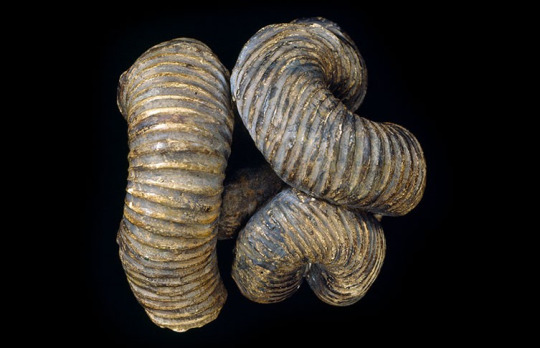
Nipponites mirabilis ammonites grew in an unusual knot shape, rather than in a typical spiral
While ammonite shells are abundant in the fossil record, it was only recently that scientists have found a very rare fossil of the soft parts of an ammonite. However, fossilised evidence of ammonite arms is yet to be found.
Until now, a lot of what we know about ammonites has been inferred based on what we see in living cephalopods.
How old are ammonites?
The subclass Ammonoidea, a group that is often referred to as ammonites, first appeared about 450 million years ago.
Ammonoidea includes a more exclusive group called Ammonitida, also known as the true ammonites. These animals are known from the Jurassic Period, from about 200 million years ago.
Most ammonites died out at the same time as the non-avian dinosaurs, at the end of the Cretaceous Period, 66 million years ago.
Zoë says, 'We didn't quite lose all of them at the end of the Cretaceous. A few species continued into the Palaeogene in the Western Interior Seaway before dying out.'

The astroid that hit Earth 66 million years ago and ended the age of dinosaurs is also thought to have been responsible for the demise of most ammonites. Image by Donald E Davis courtesy of NASA/JPL-Caltech, via Wikimedia Commons
Read more
Why did ammonites go extinct?
At the end of the Cretaceous Period, an asteroid colliding with Earth brought on a global mass extinction. A lingering impact winter halted photosynthesis on land and in the oceans, which had a major impact on food availability and was devastating for ammonites.
Nautiloids, however, which had ancient relatives that lived at the same time as ammonites, survived this mass extinction. It is thought this is in part linked to these groups' preferred water depths.
Zoë explains, 'Nautilus survived probably because it lives deeper in the ocean. Deeper environments were less affected by what was going on in shallow water environments. This is a pattern that can be seen in other groups, aside from cephalopods – fish, for example.
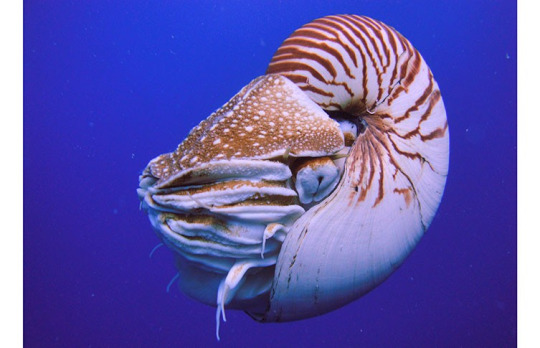
Ammonites mostly died out 66 million years ago, but other cephalopods, such as nautiluses, survived © Manuae via Wikimedia Commons (CC BY-SA 3.0)
The size of hatchlings may also have played in the nautiluses' favour as they were larger and would have been less restricted by the size of food available to them.
How many ammonite species were there?
Scientists can tell species of ammonites apart through several attributes including shell shape, size, age, location, features such as the number and spacing of ribs, defensive spines or shell-strengthening ornamentation.

We know this specimen of Kosmoceras phaeinum is a male from the long prongs, known as lappets, sticking out near the opening of the shell. They might have been used by the male to hold onto the female during mating, a bit like shark claspers.
Read more
But figuring out exactly how many species have been found so far is a bit tricky.
Like modern cephalopods, ammonites displayed sexual dimorphism, which is the noticeable difference in appearance between sexes. But when ammonite fossils that looked unique were found in the past, they tended to be recorded as new species instead of as the microconch (male) or macroconch (female) of an existing species, as this difference between the sexes was not yet known about.
However, it is estimated that over 10,000 species of ammonite - possibly even over 20,000- have been discovered.
Zoë says, 'Ammonites were quite diverse and evolved rapidly, so if you sample stratigraphically through rocks, you can actually see the evolution and the changes through them.'
How big were ammonites?
Ammonites came in a range of sizes, from just a few millimetres to times bigger, with larger sizes more common from the Late Jurassic onwards.
The largest known species of ammonite is Parapuzosia seppenradensis from the Late Cretaceous. The largest specimen found is 1.8 metres in diameter but is also incomplete. If it were complete, this ammonite's total diameter could have been from 2.5-3.5 metres.
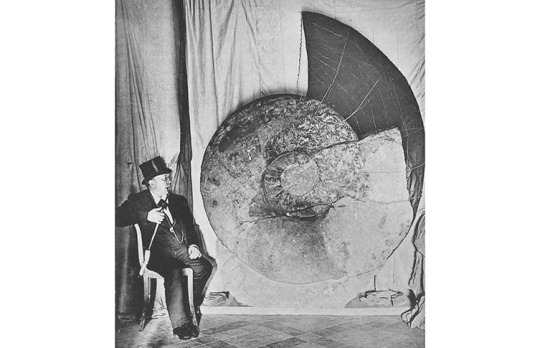
Parapuzosia seppenradensis is the largest known species of ammonite. Image via Wikimedia Commons
Where did ammonites live?
Ammonites lived all around the world. Like their modern-day cephalopod relations, they were exclusively ocean-dwelling. They tended to live in more shallow seas and may have had a maximum depth of about 400 metres.
What did ammonites eat and what ate them?
Though it would largely have depended on their size, ammonites would likely have eaten similar things to today's cephalopods, such as crustaceans, bivalves and fish. Smaller species would probably have eaten plankton. Some other species may have been scavengers, like living nautiloids can sometimes be.
Ammonites would also have served as food for other marine animals. There is evidence of mosasaurs and ichthyosaurs having eaten them, and some fish would likely also have considered them prey.

Ichthyosaurs were among the marine animals that would have preyed on ammonites
Why are ammonites important to science?
Ammonites can be a useful tool for scientists. Because they are so common and evolved so rapidly, they are excellent to help determine the age of the rocks they were fossilised in.
Much of the Mesozoic aged rock in Europe has been sectioned into 'ammonite zones', where rocks in different areas can be associated with each other based on the ammonite fossils found in them.
Zoë says, 'I've done a few identifications where there are bits of ichthyosaur and an ammonite has also been found, and they need it identifying. If you can identify the ammonite, you can really narrow things down. They're a really good indicator for biostratigraphy.'

Another potential use for ammonite fossils could be for telling us about how animals responded to climate change in the past.
Zoë explains, 'Shelled marine animals can help us look back into the past at what was going on in terms of climate change following extinction events. If we have known periods of warming or cooling, we can then infer that into modern climate science.
'Looking at size change will tell you an awful lot. Quite often after an extinction event a lot of shelled animals shrink because they don't have the resources they need to grow. If there isn't the resource to build their shells, it's a bit of a struggle for them. You see that in a lot of organisms.'
What is an ammonite? | Natural History Museum (nhm.ac.uk)
Ammonoidea
Animal
Ammonoids are extinct spiral shelled cephalopods comprising the subclass Ammonoidea. They are more closely related to living coleoids (i.e., octopuses, squid and cuttlefish) than they are to shelled nautiloids (such as the living Nautilus). The earliest ammonoids appeared during the Devonian, with the last species vanishing during or soon after the Cretaceous–Paleogene extinction event. They are often called ammonites, which is most frequently used for members of the order Ammonitida, which represented the only living group of ammonoids from the Jurassic onwards
Scientific name: Ammonoidea
Clade: Neocephalopoda
Domain: Eukaryota
Kingdom: Animalia
Phylum: Mollusca
Ammonoidea - Wikipedia
Is an ammonite fossil worth money?
Well, the largest ammonites with special characters can fetch a very high value above $1,000. Most of them are below $100 though and the commonest ammonites are very affordable. Some examples : an ammonite Acanthohoplites Nodosohoplites fossil from Russia will be found around $150.
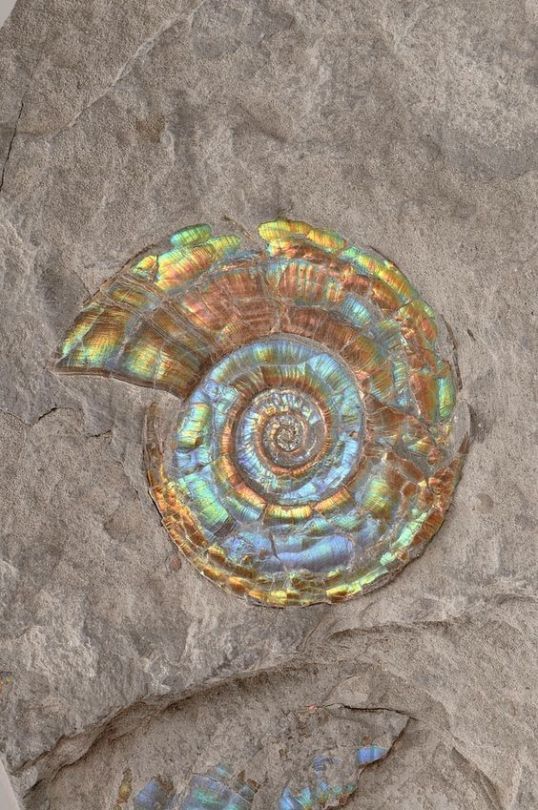
Ammonite fossil
6K notes
·
View notes
Photo

Fossil Cenoceras Nautilus - Jurassic Coast, Burton Bradstock, Dorset, UK | 100% Genuine Specimen + COA
A beautifully preserved Fossil Cenoceras Nautilus from the Inferior Oolite Formation, Jurassic Coast: Burton Bradstock, Dorset, UK. This stunning nautilus fossil is a rare and scientifically valuable specimen, perfect for collectors, educators, and fossil enthusiasts.
✅ 100% Genuine Specimen – Every fossil we sell is authentic and comes with a Certificate of Authenticity. ✅ Discovered by our own expert team – This specimen was found on 15 January 2025 by our dedicated fossil hunters, Alister and Alison. ✅ Expertly cleaned, prepped, and treated – Professionally prepared by Alison to highlight its intricate shell details and natural preservation. ✅ What you see is what you get – The listing photos show the exact specimen you will receive. ✅ Includes size reference – Scale cube in photos = 1cm. Please refer to the images for full dimensions.
About Cenoceras Fossil Nautilus:
Cenoceras is an extinct genus of nautiloid cephalopods from the Jurassic period, approximately 170 million years ago. These marine creatures are closely related to modern-day nautiluses and thrived in the warm, shallow seas of the Jurassic era. Unlike ammonites, which evolved elaborate coiling patterns, Cenoceras retained a simpler, more robust shell structure.
Fossils from the Inferior Oolite Formation are highly sought after due to their exceptional preservation and historical significance. This Cenoceras specimen provides valuable insight into Jurassic marine ecosystems and the evolution of cephalopods.
Perfect for display, educational purposes, or as a unique gift for fossil lovers and paleontology enthusiasts, this fossil is a rare and remarkable addition to any collection.
Shipping & Packaging:
🔹 Securely packed for safe transit 🔹 Worldwide shipping available 🔹 Tracked & insured delivery options
Why Buy from Us?
🔹 Trusted Seller – Specializing in fossils, minerals, and natural history specimens. 🔹 Certified Authenticity – Every purchase includes a signed Certificate of Authenticity. 🔹 Ethically Sourced – All our fossils are legally and responsibly collected by our own team.
Own a genuine piece of Jurassic history today! 🌊🐚
#Cenoceras nautilus#fossil nautilus#Jurassic nautilus#Inferior Oolite fossil#Burton Bradstock fossil#Dorset fossil#UK fossil#authentic nautilus#nautilus collector#nautilus specimen#fossil display#rare fossil#ammonite relative#prehistoric fossil#geological specimen#fossilized nautilus#nautilus shell#natural history#fossil enthusiast#fossil sale#nautilus Jurassic#nautilus UK#cephalopod fossil#paleontology#fossil identification
0 notes
Text
Here’s a near-perfect Iron Pyrite Nautilus from the Jurassic 🦑⚒️ It’s Ro...
youtube
0 notes
Text

Luneta sauropod sculpture couplefie
My daughter and I playing around with a concrete sculpture of a Sauropod (long necked dinosaur) at Children's Playground, in Luneta Park, Manila.
There are no dinosaur fossils found in the Philippines because during the age of the dinosaur of the Triassic period (between 243 and 233.23 million years ago) to the Jurassic and Cretaceous periods (145 to 66 million years ago) the Philippine archipelago was still under water.
It was by 50 million years ago did the first Philippine islands form due to undersea volcanic activity. Hence many of geological formations contain sedimentary rock such as coral stone that were used to build our old churches. Many the fossils of undersea creatures were also discovered; such as monstrous Otodus megalodon, an extinct species dugong (Sea cow / order sirenia), and the shelled Cephalopods called Ammonites (Perisphinctes Liosphinctes, Notosilesitoides philippinensis, Pseudhelicoceras spath, Hamitoides spath, and Hamites spath).
There are also fossils of sea creatures that are still surviving to this day; such as Lagan (Chambered nautilus / Nautilus pompilius), the Taklobo (Giant Clam / Tridacna gigas).
Another “living fossil” discovered in the Philippines is the Black marlin (Istiompax indica); which is called a Dugho/Tandalayang by the Zamboanga Chavacano, Malasugi by the Hiligaynon, Dol-lakak by the Ilokano, Malakay by the Ivatan, and the Malasugue by the Maranao/Samal/ Tausūg people.
The oldest fossil discovered in the Philippines is a Rugose coral (Gshelia sp.) that is believed to be around 300 million years old.
Although the Sauropod and other dinosaur sculptures at the Children's Playground may be a fantasy for many Filipino children to compare the sized of how these prehistoric animals would compare to them. In fact, I always wanted to visit these when I was a child, but my parents didn’t have the time.
So when my daughter was old enough, I would find every opportunity for us to enjoy visiting the Luneta Park.
The sculptures were created by the artist Jose Malat Mendoza (born 1939) in 1968.
This picture was taken circa 2009
Postscript:
Here is my memoire on my childhood interest in dinosaurs: “Random Memories: My Jurassic Trip” (https://www.facebook.com/photo/?fbid=10159818270301404&set=a.10159242840496404)
#filipinotraveler#travel#history#creaturefeature#philippines#lunetapark#rizalpark#dinosaur#childrenspark#manila#sculpture
0 notes
Text
Not real life vehicles, but I feel like we need some fictional ones that are less talked about
Aphelion (Her voice is so smooth)

The Nostromo, but with the equivalent energy of a monster fucker to spaceships

The Jurassic Park Jeep. This is a girlfriend who has the wildest job you've ever heard and always comes home covered in mud with a wild story about how she almost died with a grin on her face

The Nautilus, have to put a classic in here. but Nemo could ram me with his submarine

And finally, one actual real life vehicle no one will mention because they are cowards and could never treat her right
The Crawler Transporter


If ever a vehicle could be described as a creature, it would be this one. And even better, she's a megafauna at 6.65 million pounds and a top speed of 2mph unloaded (1 while carrying rockets)
reblog this post and reply with pics of the sexiest vehicles you can think of. i wanna see capital F Fuckable cars and planes and such
884 notes
·
View notes
Photo

A nice mug of hot tea after a morning’s fossil hunting on the Jurassic Coast.
Charmouth Beach, England
#fossils#geology#ammonite#nautilus#fossil hunters#fossil hunting#charmouth#jurassic coast#england#hot tea#winter holidays#exploring#adventure#adventure blog#original blog#original content#original photography
104 notes
·
View notes
Photo

When it comes to how #beautiful the fossil is, the Nautilus is on top. 💎
These #fossils are the shells of a cleoniceras #ammonite and a cenoceras #nautilus. 🐚
.
Follow @neojurassica to see more #prehistoric wonders! 🦕
.
🖥 www.neojurassica.com
🦖 Dinosaur Specialists
🦴 Genuine Fossils
⚙️ Display Customisation
🚚 Free UK Delivery
✈️ International Delivery
.
#ammonites #fossils #fossil #extinct #evolution #jurassic #jurassicpark #jurassicworld #neojurassica #jurassiccoast #nature #wildlife #naturephotography #geology #science #paleontology #palaeontology #biology #beauty #whimsical #natural #garden #countryside #gems #minerals #wonder
https://www.instagram.com/p/CNkGDkSp9XG/?igshid=1h8jg9x7ceoe1
#beautiful#fossils#ammonite#nautilus#prehistoric#ammonites#fossil#extinct#evolution#jurassic#jurassicpark#jurassicworld#neojurassica#jurassiccoast#nature#wildlife#naturephotography#geology#science#paleontology#palaeontology#biology#beauty#whimsical#natural#garden#countryside#gems#minerals#wonder
9 notes
·
View notes